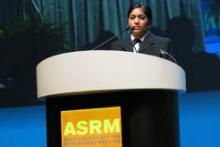HONOLULU – The only means of modifying the risk of ectopic pregnancy in fresh nondonor cycles of assisted reproductive technology is to limit the number of embryos transferred, a retrospective cohort study of 553,577 clinical pregnancies found.
Among the 379,023 clinical pregnancies from fresh nondonor cycles, the risk of ectopic pregnancy increased by 33%-49% with the transfer of more than two embryos, compared with transferring one embryo, Dr. Kiran M. Perkins reported at the annual meeting of the American Society for Reproductive Medicine.
The incidence of ectopic pregnancy in pregnancies from fresh nondonor cycles was 1.6% with the transfer of one embryo, 1.7% with the transfer of two embryos, 2.2% with the transfer of three embryos, and 2.5% with the transfer of four or more embryos, said Dr. Perkins of the Centers for Disease Control and Prevention.
The overall incidence of ectopic pregnancy in this cohort of 553,577 clinical pregnancies from assisted reproductive technology (ART) procedures was 1.7%, similar to the 2% incidence among the general U.S. population, she added. From January 2001 to the end of 2011, there was a significant downward trend in the incidence of ectopic pregnancy after ART procedures, from 2% in 2001 to 1.6% in 2011.
Most of the clinical pregnancies from ART occurred after fresh nondonor cycles (68%), followed by frozen-thawed nondonor cycles (15%), fresh donor cycles (12%), and frozen-thawed donor cycles (4%). (Percentages were rounded.)
Fresh nondonor cycles were associated with the highest rate of ectopic pregnancy (2%). Rates of ectopic pregnancy were 1.3% using frozen-thawed nondonor cycles, 1.2% using frozen-thawed donor cycles, and 1% using fresh donor cycles.
The study identified other risk factors for ectopic pregnancy after ART, but these were not things that clinicians could modify. The ectopic pregnancy risk after fresh nondonor cycles increased with age between the ages of 29 and 44 years, with an adjusted risk ratio of 21%-23%. The rates of ectopic pregnancy increased from 1.6% in women younger than 30 years to 1.9% for ages 30-34 years, 2.1% for ages 35-37 years, 2.2% for ages 38-40 years, and 2.4% for ages 41-43 years.
Women with a history of two or more ART cycles had a significantly increased incidence of ectopic pregnancy, compared with women with no prior ART cycles: 2.3% vs. 1.8%, Dr. Perkins reported.
Having one or more prior live births was protective, reducing the risk of ectopic pregnancy by 29% in women with one prior live birth and by 45% in women with two or more prior births, compared with nulliparous women. Ectopic pregnancy rates were 2.1% in women with no prior births, 1.7% in those with one prior live birth, and 1.4% in those with two or more previous births.
The 2.3% incidence of ectopic pregnancy in couples with tubal factor infertility was significantly higher than the 1.8% incidence in couples with male factor infertility.
Data for the study came from the National ART Surveillance System, which contains information on 95% of ART procedures in the United States.
Dr. Perkins reported having no relevant financial disclosures.
On Twitter @sherryboschert


